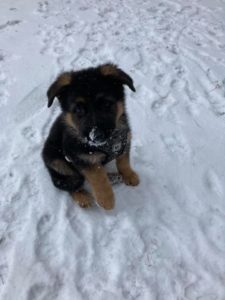January is National Walk Your Dog Month and National Train Your Dog month. While many of us may shiver at the thought of taking our dog on a January walk, it is important to realize our pets still need mental and physical stimulation during winter months. Safety precautions should always be kept in mind when spending time outside during the brisk winter weather. Just like their human counterparts, puppies, senior dogs and those with lung problems are especially susceptible to cold air. Please limit their exposure to the chilly weather. For all other canines please keep the following tips in mind.
 When snow falls or ice accumulates, ice melt is used to make surfaces safer for travel. Although no one wants to fall on ice, some ice melt can cause irritation to a dog’s paws. If your pooch will tolerate boots they offer great protection. Another option is applying a wax protectant to your dog’s paws. This technique is used for working dogs in winter climates. Always make sure you gently wipe off a dog’s paws when he comes inside from a winter walk.
When snow falls or ice accumulates, ice melt is used to make surfaces safer for travel. Although no one wants to fall on ice, some ice melt can cause irritation to a dog’s paws. If your pooch will tolerate boots they offer great protection. Another option is applying a wax protectant to your dog’s paws. This technique is used for working dogs in winter climates. Always make sure you gently wipe off a dog’s paws when he comes inside from a winter walk.
Although many fluffy, giant breed dogs seem to enjoy winter temperatures, it’s important to do an assessment of your dog’s coat, body condition, and breed before gearing up for a long, cold trek outside. Dogs with short hair, and low body fat or those bred for warmer climates will definitely need weatherproof outerwear before going outside. Most dogs in this area are indoor pets, their bodies, like ours, are not accustomed to spending time in extreme weather without protection.
If your pet does not have a good recall and you will be walking near bodies of water, keep them on a leash. Ice poses a serious danger to pets. Our pets do not have a natural intuition to stay off thin ice. An owner who tries to rescue their pet may drown as well. Thin ice is very dangerous. The formation of ice on a pond is a complex process. Scientists have a formula to calculate the number of days before a lake is safe to walk on. The only way to truly tell if the ice is safe is to manually check the depth with a drill. Never allow your pet to walk on frozen streams or rivers.
If braving the winter weather is not your style please know there are many ways to mentally stimulate your dog inside.
- Teach your dog a new trick. It is National Dog Training month!
- Play hide and seek with a treat, toy, or another family member.
- Jog up and down the stairs.
- Enroll your dog in doggie daycare.
No matter the weather, let’s show some love to our canine friends. Exercise and training provide much-needed stimulation decreasing the potential for destructive behaviors and increasing your bond.

